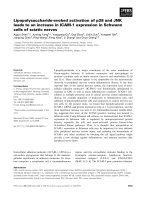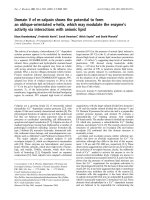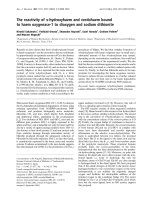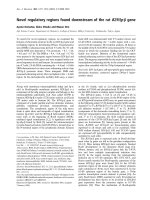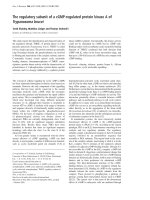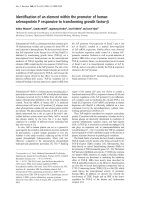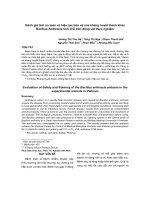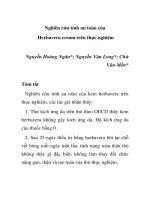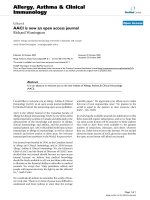Báo cáo y học: "T regulatory cells: an overview and intervention techniques to modulate allergy outcome" ppsx
Bạn đang xem bản rút gọn của tài liệu. Xem và tải ngay bản đầy đủ của tài liệu tại đây (677.66 KB, 8 trang )
BioMed Central
Page 1 of 8
(page number not for citation purposes)
Clinical and Molecular Allergy
Open Access
Review
T regulatory cells: an overview and intervention techniques to
modulate allergy outcome
Subhadra Nandakumar
1
, Christopher WT Miller
2
and Uday Kumaraguru*
1
Address:
1
Department of Microbiology, College of Medicine, East Tennessee State University, Johnson City, TN-37614, USA and
2
Division of
Allergy and Immunology, Department of Internal Medicine, College of Medicine, East Tennessee State University, Johnson City, TN-37614, USA
Email: Subhadra Nandakumar - ; Christopher WT Miller - ;
Uday Kumaraguru* -
* Corresponding author
Abstract
Dysregulated immune response results in inflammatory symptoms in the respiratory mucosa
leading to asthma and allergy in susceptible individuals. The T helper type 2 (Th2) subsets are
primarily involved in this disease process. Nevertheless, there is growing evidence in support of T
cells with regulatory potential that operates in non-allergic individuals. These regulatory T cells
occur naturally are called natural T regulatory cells (nTregs) and express the transcription factor
Foxp3. They are selected in the thymus and move to the periphery. The CD4 Th cells in the
periphery can be induced to become regulatory T cells and hence called induced or adaptive T
regulatory cells. These cells can make IL-10 or TGF-b or both, by which they attain most of their
suppressive activity. This review gives an overview of the regulatory T cells, their role in allergic
diseases and explores possible interventionist approaches to manipulate Tregs for achieving
therapeutic goals.
Review
The current economic crisis and the fiasco at the stock
market bring forth the importance of regulation. Be it
Wall Street or our immune system, the indomitable pres-
ence and watchful eye of a regulator cannot be under-
stated. The cells that perform this specialized regulator
function (natural Tregs) in the immune system have
gained prominence with a detailed description and char-
acterization of their identity. We discuss in this review the
role of these regulators in the context of allergic diseases
and how they could be manipulated for therapeutic goals.
Historical Perspective
The early report suggesting the presence of immune regu-
lation dates back to 1905, when Paul Ehrlich and J. Mor-
genroth reported that immunization was not successful
against self-tissues. Several decades later, R. E. Billingham
et al. discovered the immunological basis of tolerance or
immune regulation[1]. Using a murine skin model, they
demonstrated that the mice immunized with allografts in
utero were able to accept skin grafts from the allogenic
mice [2]. It was in 1969, that Nishizuka and Sakakura,
reported the first experiments that potentially indicated
the presence of T cells with immuno-regulatory potentials
[3]. However, a seminal observation in 1970 by Gershon
et al. suggested the occurrence of immunological toler-
ance and attributed it to T cells [4]. But it took Sakaguchi
et al. to characterize these regulatory cells as CD4
+
CD25
+
natural T regulatory cells. They found that athymic BALB/
c mice developed autoimmune diseases, when given a
population of CD4
+
CD25
+
T cells. Nevertheless, this phe-
nomenon was reversed when the mice were adoptively
Published: 12 March 2009
Clinical and Molecular Allergy 2009, 7:5 doi:10.1186/1476-7961-7-5
Received: 1 January 2009
Accepted: 12 March 2009
This article is available from: />© 2009 Nandakumar et al; licensee BioMed Central Ltd.
This is an Open Access article distributed under the terms of the Creative Commons Attribution License ( />),
which permits unrestricted use, distribution, and reproduction in any medium, provided the original work is properly cited.
Clinical and Molecular Allergy 2009, 7:5 />Page 2 of 8
(page number not for citation purposes)
transferred with quiescent CD4
+
CD25
+
T cells [5] reveal-
ing their immuno-suppressive effect. Further understand-
ing of the constitution of T regulatory cells came from the
discovery of the involvement of the forkhead box P3
(foxp3) [6], also known as transcription factor Scurfin in
the regulation of immune response. The original scurfy
mouse model was characterized by a mutation in the X
chromosome resulting in immune dysfunction leading to
splenomegaly, hepatomegaly, lymphadenopathy and
early death. Interestingly, mutation of the human gene
Foxp3, an ortholog of the gene mutated in scurfy mice
(Foxp3) was also the cause for human immunodysregula-
tion polyendocrinopathy enteropathy X-linked syndrome
(IPEX), another sex-linked autoimmune syndrome[7].
Further studies showed that the Foxp3 was largely
expressed in CD4
+
CD25
+
T cells; and retroviral transduc-
tion of conventional CD4
+
T cells with Foxp3 converted
them to regulatory T cells with suppressive ability [6,8,9].
Thus, the current understanding is that the natural T regu-
latory cells are cells that possess the CD4
+
CD25
+
Foxp3
+
phenotype.
Development and homeostasis of the T regulatory cell
The development of CD4
+
regulatory T cells occurs in the
thymus from a separate lineage, but can also develop in
the periphery and circulate back to thymus as reviewed by
Rudensky [10]. In general, the development of hemat-
opoietic cells initiate in the bone marrow from where the
thymic lineage cells travel to the thymus. The T cells, from
the double negative (DN) phenotype (CD4
-
CD8
-
)
become double positive (DP) (CD4
+
CD8
+
) upon interac-
tion of the T cell receptor (TCR) with the major histocom-
patibility complex (MHC) and peptides. It is in the thymic
medullary region where the cells gain single positive phe-
notype and progress to develop either as CD4
+
(CD4
+
CD8
-
) or CD8
+
(CD4
-
CD8
+
) T cells respectively. The
thymic medulla is also the location for the selection of
CD4
+
CD25
+
cells [11] and commitment to Foxp3+ T reg-
ulatory cell lineage. The transcription factor Foxp3 was
found to be expressed even in the DP cells, but they are
turned on only in the single positive (SP) cells. The devel-
opment of T regulatory cells involves a two step process as
surmised by Liston et al. [12]. The first step is the encoun-
ter of the TCR with a self peptide on MHC-II, followed by
exposure to B7 ligands and γc chain cytokines particularly
IL-2 [10,12,13]. The induction of Foxp3 may however
require CD28 ligation [14]. The T regulatory cells then
make their way to the periphery to manifest their function
and also are subjected to peripheral homeostatic mecha-
nisms.
Apart from a few similarities, the homeostatic control
mechanism of Tregs is different from conventional T cells.
The TCR signaling is not critical for homeostatic mecha-
nism of T regs, but it depends on three main factors as
summarized by Liston et al. in their review [12]: IL-2,
TGFβ and CD28 ligation. IL-2 induces the proliferation of
Tregs and also contributes to their efficiency and fitness in
the periphery [15]. TGFβ is needed for maintenance of
Tregs, because in its absence the peripheral numbers goes
down inspite of normal thymic output [16], Likewise,
CD28 engagement known to be critical in the thymus
seems to affect the homeostasis of Tregs in the periphery
as well. Blocking of CD28 interaction with its ligands
CD80 and CD86 resulted in reduced Treg numbers in the
periphery [17].
Types of Regulatory T cells
Any T cell that has the ability to suppress the immune
response is known as a regulatory T cell. These cells are
broadly classified as natural T regulatory cells and induced
or adaptive T regulatory cells. The natural T regulatory
cells (nTreg) are self antigen specific CD4
+
T cells that
express CD25 in high levels and Foxp3. In addition, their
phenotype is also characterized by the expression of CD62
ligand, CD103, glucocorticoid induced tumor necrosis
factor receptor (GITR), Cytotoxic T-Lymphocyte Antigen 4
(CTLA-4), CD152, neurophilin and CD45RO [13,18].
The nTregs are selected in the thymus, and become regu-
latory T cells in the periphery.
The adaptive or induced T regulatory cells arise as a result
of activation of mature T cells in the absence of optimal
antigen exposure or, costimulation or in the presence of
certain inhibitory cytokines. The induced Tregs include
the type 1 regulatory T cells (Tr1) and Th3 cells. The Tr1
cells have both Th1 and Th2 phenotypic markers (chem-
okine receptors) like the CXCR3, CCR5, CCR3, CCR4 and
CCR8. When activated they express CD40L, CD69, CD28,
CTLA-4, IL-2R-α, IL-15Rα and HLA-DR. The Tr1 cells are
characterized by an elevated production of IL-10, TGF-β
and IL-5. Naïve CD4
+
T cells in the presence of immuno-
suppressive drugs, soluble proteins and chronic stimula-
tion with allergic, infectious or tumor antigen develop
into IL-10 producing Tr1 cells [19,20]. These cells lead to
the development of a heterologous mode of suppression
to non-specific antigens by the secretion of IL-10 or
through mediation by CTLA-4, TGF-β, GITR or PD-1 [21].
The Th3 cells that are induced by oral antigen administra-
tion exert their suppressive activity by the production of
TGFβ(reviewed in) [22].
T cells in Allergy
Allergy is defined as an exaggerated response of the
immune system to common environmental substances or
'allergens'. Coombs and Gel in 1970 classified the allergic
manifestations into four different types [23]. All the four
types of hypersensitivity involve either the exaggerated
response of the T cells or the B cells. Most of the allergic
responses involve the Th2 CD4
+
T cells. In the case of type-
Clinical and Molecular Allergy 2009, 7:5 />Page 3 of 8
(page number not for citation purposes)
I hypersensitivity, the Th2 cells, upon coming in contact
with the APC presenting an allergen, upregulates CD40
ligand on their surface which interacts with the CD40 on
the B cells. This is accompanied by the production of Th2
related cytokines like IL-4, IL-5 and IL-13. A class switch-
ing of the immunoglobulins leads to the production of
IgE from IgG. The IgE in turn interacts with basophils
resulting in their degranulation and release of histamines,
prostaglandins, chemokines and cytokines leading to
smooth muscle contraction, increased vascular permea-
bility, recruitment of more Th2 cells and eosinophils and
release of neuropeptides [24-26]. The type-II and type-III
hypersensitivity reactions involve complements and IgG.
The type-IV hypersensitivity is mediated by antigen spe-
cific T cells, wherein the sensitized effector cells produce
various cytokines including IFNγ and IL-17 and result in
an inflammatory reaction.
Th1 and Th2 differentatiation
In 1989, Mosmann and Coffman reported that CD4
+
T
helper cells could be divided based on their cytokine pro-
file[27]. The Th1 cells produce IL-2, IFNγ and LTα and
their development is regulated by the transcription factors
T-bet and STAT-4. For their part, the Th2 cells are regu-
lated by STAT-6, c-maf and GATA-3 and they produce
cytokines such as IL-4, IL-5, IL-9 and IL-13. The Th1 type
response is effective against intracellular infections and
the Th2 type is required in the case of parasitic infections.
Hyper activation of Th1 and Th2 type responses results in
over production of cytokines leading to auto-immune dis-
orders and allergic diseases respectively. The presence of
T-regulatory cells in both scenarios prevents diseases man-
ifestations by suppressing their activity.
Th17 and Treg conundrum
Implications for a major role for the cytokine IL-17, pro-
duced by a novel subset of helper cells aptly named as the
Th17 have been demonstrated in the case of auto-
immune diseases. IL-17 causes inflammation and induces
macrophages to produce pro-inflammatory cytokines
including IL-6. The cytokine IL-6 has been previously
shown to inhibit the development of Tregs [28]. This
novel dual function of Th17 cells, i.e. being proinflamma-
tory and Treg suppressive, makes them an antithesis of
Tregs in the context T cell mediated immune response.
Given this background, the role of T cells in allergy is com-
plex and probably tightly regulated for the right reason.
Immune regulation by Regulatory T cells
The suppression or regulation of the immune response by
T cells occurs by various pathways. This has been reviewed
exhaustively and elegantly by Rouse [20]. We review here
some of the mechanisms by which regulatory T cells
achieve their immuno-suppressive effects. When non-pro-
fessional APC present antigens to T cells and there is an
absence or reduced expression of costimulatory molecules
like CD80 or CD86, it results in deficient immune activa-
tion and anergy. The latter could also result in the pres-
ence of CTLA-4 on T cells. These interact with CD80 and
CD86 on dendritic cells and result in the production of
indoleamine 2, 3-dioxygenase (IDO), which metabolizes
tryptophan and leads to a decrease in the activation of T
cells [11,13,29].
The presence of a greater amount of antigen or a high
degree of T cells activation could also lead to immune sup-
pression by activation induced cell death. This process is
predominantly mediated by FAS-FAS-ligand. This interac-
tion leads to the activation of caspase enzymes which
results in the degradation of chromosomal DNA and
apoptotic cell death [13]. Activation induced T cell death
also occurs as a result of activation of CD4
+
CD25
+
Foxp3
+
cells by CD3 and CD46. Activation of the Tregs upregu-
lates the expression of granzyme A and eventually the
Tregs can eradicate activated CD4
+
and CD8
+
T cells in the
presence of perforin [13].
In the event of lower concentrations of IL-2, the suppres-
sive function of the T cells is enhanced. This is explained
by the fact that the Tregs have a higher level of IL-2 recep-
tor expression; thereby possessing a greater ability to uti-
lize the cytokine and deprive the other T cells of IL-2. The
latter is a T cell growth factor and essential for T cell pro-
liferation with its deficiency resulting in a hampered mul-
tiplication of the T cells. This was postulated to be the
mechanism of suppression that is independent of
cytokines such as IL-10 and TGF-β [25,30,31].
In patients with atopic dermatitis, there is a remarkable
absence of CD4
+
CD25
+
Foxp3
+
Treg cells within the skin
lesions, with a consequent lack of effector T cell suppres-
sion [32]. Primarily, the T-regulatory cells produce IL-10.
This cytokine directly and indirectly suppresses the activ-
ity of mast cells, basophils and eosinophils [33]. IL-10
also prevents the class switching from IgG4 to IgE [24,34].
These functions are also carried out by the TGF-β secreted
by the Treg cells. TGFβ interacts with fibroblasts and
myofibroblasts and is known to reduce peribronchiolar
extracellular matrix deposition and airway smooth muscle
cell proliferation [19]. The mast cell degranulation is also
suppressed by the interaction of OX40 on the Tregs with
OX40 ligands on the mast cells [35]. It also prevents the
secretion of IL-9 and IL-3 by the Th2 cells, thereby pre-
venting the mucus production in the lung. The Tregs also
inhibit the function of the Th1 and Th2 CD4
+
T cells and
their production of cytokines in addition to suppressing
the CD8
+
T cell activity [13]. The effect of the Tregs on
these immune cells consequently results in a reduced
allergic pathology caused by the immune reaction. With
Clinical and Molecular Allergy 2009, 7:5 />Page 4 of 8
(page number not for citation purposes)
this knowledge, the T regulatory cells have been
researched extensively to employ them as a mode of
allergy prevention.
Manipulating Tregs cells
Deficiency of Treg cells has been implicated in autoimmu-
nity, graft rejection, and atopic diseases. Recent insights
into in vitro and in vivo manipulation of these cells has led
to exciting new discoveries and prospects with regards to
therapeutic targeting of Treg cells to diminish the emer-
gence or intensity of disease processes. This type of
research has seen considerable advance in recent years,
particularly pertaining to Foxp3+ Treg cells and IL-10-pro-
ducing T cells. This review will focus on the therapeutic
potential of Treg cells in allergic diseases. The basic prin-
ciple behind this form of therapy resides in aiming for
both natural and IL-10-secreting Tregs in order to suppress
exaggerated Th2 reactions.
However, technical barriers have emerged, mainly in the
form of how to promote in vitro proliferation of
CD4
+
CD25
+
T cells. Godfrey et al., via stimulation of cul-
tured cells with high doses of IL-2 and beads coated with
anti-CD3 and anti-CD28, generated a 100-fold expansion
in cell number while retaining a strong suppressive func-
tion [36]. An even more impressive result was obtained
with high-dose of IL-2 and artificial antigen-presenting
cells (for repeated stimulation through CD3 and CD28),
achieving a 40,000-fold increase in cell counts while
retaining the expression of CD25 and lymph node hom-
ing receptors and displaying a greater suppressive power
than freshly isolated CD4
+
CD25
+
T cells [37]. It is impor-
tant to emphasize that antigen specificity of Tregs should
be carefully controlled in order to avoid development of
auto-reactive effector T cells or Tregs possessing erroneous
antigenic specificity [33].
One of the potential targets for development of therapeu-
tic agents is the transcription factor, shown to be selec-
tively expressed in natural Tregs. In addition, retroviral
gene transfer of Foxp3 causes naïve T cells to display a reg-
ulatory T cell phenotype similar to that of natural Tregs
[6]. Foxp3 is the ultimate regulator of Treg expression, and
hence has a vital role in promoting immune suppression
through Treg activity, as shown in a murine model in
which a fatal autoimmune syndrome was avoided in null
mice by ectopic expression of and/or transfer of
CD4
+
CD25
+
T cells into these subjects [8]. This highlights
the potential use of induction to enhance suppression of
the Th2 induced allergic response. Currently various strat-
egies are adopted to up-regulate the Treg cells in condi-
tions of allergy, transplantation and autoimmune
diseases.
Immunotherapy
The main principle behind immunotherapy in atopic
patients is to increase the number of Tregs, well known to
diminish the pulmonary inflammatory response to air-
borne allergens, as shown in murine models by both Treg
depletion and adoptive transfer of Tregs [38,39]. Subcuta-
neous immunotherapy in asthmatics has already been in
use, but titrating the dosing and treatment schedules
remains a challenge [40]. Utilizing specific subcutaneous
immunotherapy enhances Treg proliferation and produc-
tion of IL-10 [41], and development of specific T cell pep-
tide-based immunotherapy is currently under way [42].
IL-2 has been shown to have a critical role in thymic devel-
opment, expansion within peripheral blood, and the sup-
pressive activity of CD4
+
CD25
+
Foxp3
+
Tregs [43,44],
although the exact mechanism behind its influence on
these cells is still under study. Blockade of the IL-2 recep-
tor pathway in peripheral Tregs led to decreased suppres-
sive function and slower growth [45] as well as a greater
predisposition to development of autoimmune disease
[46]. As an attractive candidate for in vivo therapy, a
number of studies have surfaced in which cytokine
manipulation was explored, demonstrating the positive
effect of recombinant IL-2 (rIL-2) on Treg expansion
[44,47]. However, this observation has been challenged
by a recently published article by Wilson et al., in which
worsening of airway inflammation was observed in
murine subjects treated with rIL-2 [48]. In contrast, when
IL2:anti-IL-2 complexes were administered both before
and after allergenic stimulation, a remarkable increase in
Treg counts was observed along with an increase in mRNA
and IL-10 levels in lung tissue; in addition, subjects dis-
played decreased pulmonary pathologic findings (mucus
secretion, airway inflammation and hyper-responsive-
ness), corroborating a similar report by Boyman et al.
[49]. The IL2:anti-IL-2 complex has been shown to cause
enhanced secretion of IL-35, a cytokine which expands
Tregs and augments their secretion of IL-10 [50], an
important mediator in controlling airway inflammation
[51]. The reasons for these findings are not entirely clear,
but several hypotheses can be postulated. Even though the
current thought is that IL-2 contributes more heavily
towards immune tolerance, T effector cells (Teff), which
have a proinflammatory action, can also be activated by
IL-2 under certain conditions [52], and a preferential Teff
cell activation may have taken place in the subjects pre-
senting worsening symptoms when exposed to rIL-2.
Interestingly, complexing IL-2 with an antibody stabilizes
the cytokine and increases its half-life; the reported effects
of this on T cell populations is not uniform, as studies
have shown that preferential CD4
+
or CD8
+
T cells can
occur depending on which anti-IL-2 clone is utilized
[48,53,54].
Clinical and Molecular Allergy 2009, 7:5 />Page 5 of 8
(page number not for citation purposes)
In a mouse model, splenic DCs have been targeted to
induce the Foxp3+ Treg cells. Monoclonal antibodies to
the CD11c
+
DEC205
+
CD8
+
subtype of DC resulted in
reduced ability of these cells to present antigen to the CD4
T cells [55]. This repeated stimulation of T cells with
immature DCs resulted in elevated IL-10 production. Fur-
thermore, it suppresses the cytokine producing ability of
the CD8+ T cells. TRAIL (TNF-related apoptosis inducing
ligand) is another molecule reported to expand
CD4
+
CD25
+
T cells in mouse models.
Steroids
There is a large volume of evidence suggesting that
CD4
+
CD25
+
T cells have an active role in suppressing the
Th2 response seen in allergic reactions, and that patients
with deficient cell counts would be overwhelmed by expo-
sure to allergens and thus unable to adequately harness
their immune response. Ling et al. demonstrated that,
when compared with non-atopic controls, CD4
+
CD25+
cells of atopic patients have an impaired ability to sup-
press proliferation and IL-5 release by CD4
+
CD25
-
T cells,
particularly in patients with hay fever assessed during the
pollen season [56]. However, upon removal of
CD4
+
CD25
+
T cells from the blood of non-atopic patients,
exposure to allergens led to a Th2 cytokine profile compa-
rable to atopics [57]. A study by Hartl et al. compared sev-
eral cell and chemokine parameters in asthmatic and
healthy children. While peripheral blood analysis failed
to reveal a difference in absolute numbers of
CD4
+
CD25
+
T cells, bronchoalveolar lavage fluid of asth-
matic children possessed significantly diminished levels
of CD4
+
CD25
+
T cells and IL-10 and TGF-β mRNA [58].
These same markers were found to be higher in asthmatic
patients using inhaled corticosteroids when compared
with patients not on this form of therapy [58].
Corticosteroids are known to actively suppress the Th2
response, and mounting evidence has shown that this
activity is derived from their stimulatory effect on Tregs,
inducing the latter to augment secretion of IL-10 and
expression of Foxp3 [59,60], while administration of anti-
IL-10 antibody reversed the steroid-induced suppression.
In addition, T cells in corticosteroid-resistant asthmatics
have diminished IL-10 secreting capacity as compared to
corticosteroid-sensitive subjects [61], reinforcing the
importance of this activity in the clinical efficacy of ster-
oids. Peek et al. demonstrated that combining an inhaled
corticosteroid with an inhaled beta-2 agonist (namely,
salmeterol) had an additive effect in promoting IL-10
secretion and blocking the release of the Th2 cytokines IL-
5 and IL-13 [62]. However, this inability to secrete IL-10 is
reversible, as demonstrated in a study in which steroid-
resistant asthmatics who received calcitriol (0.5 mcg per
day for 7 days) in addition to dexamethasone presented
IL-10 levels comparable to steroid-sensitive subjects,
establishing vitamin D3 as an important ancillary agent in
restoring the IL-10 secreting capacity of Tregs [63]. Conse-
quently, IL-10 acts to increase expression of the glucocor-
ticoid receptor (previously downregulated by the presence
of dexamethasone). Incidentally, glucocorticoids are
known to favor Treg proliferation while limiting that of
Teff, and their use as adjuvant therapy along with IL-2 has
shown promise, supported by a study in which 300,000
IU of IL-2 daily in combination with dexamethasone sig-
nificantly expanded CD4
+
CD25
+
Tregs [47].
PAMPs
PAMPS (or pathogen associated molecular patterns) are
the molecular signature of microbial infections. PAMPs
include various microbial components such as the glyco-
proteins, lipoproteins, DNA, RNA, etc. These biomole-
cules interact with pattern recognition receptors (PRR) on
host immune cells and potentiate an innate immune
response and subsequently the adaptive response. One of
the PRRs in the mammalian system is the toll like recep-
tors (TLR). Studies have shown that Treg function could
be augmented through their engagement of TLRs. Acting
via TLR-2 and TLR-5, respectively, heat-shock protein 60
(HSP60) and flagellin enhance the suppressive functions
of CD4
+
CD25
+
T cells and, in the case of flagellin, the
expression of Foxp3 was also enhanced [64-66]. Tregs
treated with HSP60 promoted T cell inhibition through
both direct cell contact and production of IL-10 and TGFβ.
Our studies in mice have shown that constant stimulation
with Herpes simplex virus-1 for more than 9 months in
C57BL/6 mice increased the frequency of CD4
+
CD25
+
Foxp3
+
cells in their spleen and regional lymph
nodes (Nandakumar and Kumaraguru, Unpublished).
HSV is known to engage TLR-2, 3 and 9 and upregulate
these TLRs on dendritic cells and CD8
+
T cells. The con-
stant antigenic stimulation reduced the CD8
+
T cell func-
tion, in addition to upregulating the frequency of
regulatory T cells.
In a murine asthma model, pre-treatment with Mycobacte-
rium vaccae resulted in reducing the lung histopathology
[67,68]. Other microbial agents aiding the induction of
regulatory T cells included measles virus and hepatitis C
virus [69,70]. Though TLR ligands are promising targets
for future Treg-directed therapy, it is important to study
the dosage schedule and timing of the PAMP stimulation
needed to obtain the required outcome. Incidentally,
microbial exposure pattern during childhood may be a
determining factor in the allergy outcomes in adults. This
has been one of the focuses of our laboratory currently.
We plan to expand the studies to analyze the impact of
neonatal microbial exposure on the development of aller-
gies in Western world compared to developing or under-
Clinical and Molecular Allergy 2009, 7:5 />Page 6 of 8
(page number not for citation purposes)
developed countries. Collectively, these are studies
attempting to prove the popular "hygiene hypothesis".
Immunosuppressive Agents
Rapamycin is an immunosuppressive agent used in allo-
graft rejection prevention; it has recently been shown that
this drug can selectively expand CD4+CD25+Foxp3+ T
cells in mice, potentially serving as a therapeutic option in
T-cell diseases [71]. Rapamycin also expanded the per-
centage of suppressive CD8+ T cells, especially those
expressing CD103 [72]. Another immunosuppressive
agent fingolimod (FTY270), a sphingosine-1-phosphate
receptor 1 modulator, expanded antigen specific regula-
tory T cells. FTY270 exhibited the ability to convert Foxp3
negative cells to Foxp3 positive cells [73].
The role of estrogen in maintaining immune tolerance in
normal individuals has been well described, as well as its
importance in preventing autoimmune disease. Even at
physiological levels, estradiol has been shown to increase
levels of CD4+CD25+ T cells, Foxp3 expression, and IL-10
expression [74,75]. As CD4+CD25+ T cells are paramount
for development of fetal tolerance during pregnancy, the
higher circulating levels of estrogen during gestation rep-
resent an adaptive mechanism to increase Treg expression.
Exercise
Benefits of regular exercise in the management of allergy
and asthma are ample. Yeh et al. reported that regular tai
chi exercise induced the mobility and function of T regu-
latory cells. The frequency of CD4
+
CD25
+
T cells produc-
ing TGF-β and IL-10 increased almost by two fold upon
regular exercise [76]. These results also correlated with our
work, where individuals performing regular anaerobic
exercises like lifting weights had significantly higher levels
of regulatory T cells. The CD4
+
CD25
+
Foxp3
+
T cells in reg-
ular anaerobic exercisers were three times greater com-
pared to the control group (unpublished).
Parting Thoughts
With the existing knowledge on T regulatory cells, several
interventional techniques can be employed to modulate
the development and function of these cells. The exploita-
tion of Tregs is essential in circumstances like allergy,
autoimmunity and transplantation. Although the most
used method of Treg frequency enhancement is the use of
steroids, the use of these biocomponents is loaded with
various side effects. Current research has emphasized the
ability of certain other factors for improving Treg levels.
These include regular exercise and constant PAMP stimu-
lation, which could be attained by the use of various pro-
biotics or prebiotics.
Competing interests
The authors declare that they have no competing interests.
Authors' contributions
SN, Post Doctoral Research Associate, works on the role of
Tregs in Exercise, Chronic Infections and neonatal micro-
bial exposure studies. CWTM, Resident, Division of
Allergy and Immunology, Dept. of Internal Medicine, is
the clinical collaborator and contributed towards the ther-
apeutic potentials of Tregs. UK, Immunology Faculty in
the Department of Microbiology. He has been working on
regulatory T cells and is the Supervisor and Mentor for Dr.
Nandakumar.
Acknowledgements
The research in UK's lab is supported by the Start up funds from the Col-
lege of Medicine and the neonatal studies was funded by RDC grant from
the ORSPA, ETSU, Johnson City, TN-37614.
References
1. Billingham RE, Brent L, Medawar PB: Actively acquired tolerance
of foreign cells. Nature 1953, 172:603-606.
2. Schwartz RH: Natural regulatory T cells and self-tolerance.
Nat Immunol 2005, 6:327-330.
3. Nishizuka Y, Sakakura T: Thymus and reproduction: sex-linked
dysgenesia of the gonad after neonatal thymectomy in mice.
Science 1969, 166:753-755.
4. Gershon RK, Kondo K: Cell interactions in the induction of tol-
erance: the role of thymic lymphocytes. Immunology 1970,
18:723-737.
5. Sakaguchi S, Sakaguchi N, Asano M, Itoh M, Toda M: Immunologic
self-tolerance maintained by activated T cells expressing IL-
2 receptor alpha-chains (CD25). Breakdown of a single
mechanism of self-tolerance causes various autoimmune dis-
eases. J Immunol 1995, 155:1151-1164.
6. Hori S, Nomura T, Sakaguchi S: Control of regulatory T cell
development by the transcription factor Foxp3. Science 2003,
299:1057-1061.
7. Bennett CL, Christie J, Ramsdell F, Brunkow ME, Ferguson PJ,
Whitesell L, Kelly TE, Saulsbury FT, Chance PF, Ochs HD: The
immune dysregulation, polyendocrinopathy, enteropathy,
X-linked syndrome (IPEX) is caused by mutations of FOXP3.
Nat Genet 2001, 27:20-21.
8. Fontenot JD, Gavin MA, Rudensky AY: Foxp3 programs the
development and function of CD4+CD25+ regulatory T
cells. Nat Immunol 2003, 4:330-336.
9. Khattri R, Cox T, Yasayko SA, Ramsdell F: An essential role for
Scurfin in CD4+CD25+ T regulatory cells. Nat Immunol 2003,
4:337-342.
10. Fontenot JD, Rudensky AY: A well adapted regulatory contriv-
ance: regulatory T cell development and the forkhead family
transcription factor Foxp3. Nat Immunol 2005, 6:331-337.
11. Maggi E, Cosmi L, Liotta F, Romagnani P, Romagnani S, Annunziato F:
Thymic regulatory T cells. Autoimmun Rev 2005, 4:579-586.
12. Liston A, Rudensky AY: Thymic development and peripheral
homeostasis of regulatory T cells.
Curr Opin Immunol 2007,
19:176-185.
13. Romagnani S: Regulation of the T cell response. Clin Exp Allergy
2006, 36:1357-1366.
14. Tai X, Cowan M, Feigenbaum L, Singer A: CD28 costimulation of
developing thymocytes induces Foxp3 expression and regu-
latory T cell differentiation independently of interleukin 2.
Nat Immunol 2005, 6:152-162.
15. Fontenot JD, Rasmussen JP, Gavin MA, Rudensky AY: A function for
interleukin 2 in Foxp3-expressing regulatory T cells. Nat
Immunol 2005, 6:1142-1151.
16. Marie JC, Letterio JJ, Gavin M, Rudensky AY: TGF-beta1 maintains
suppressor function and Foxp3 expression in CD4+CD25+
regulatory T cells. J Exp Med 2005, 201:1061-1067.
17. Tang Q, Henriksen KJ, Boden EK, Tooley AJ, Ye J, Subudhi SK, Zheng
XX, Strom TB, Bluestone JA: Cutting edge: CD28 controls
peripheral homeostasis of CD4+CD25+ regulatory T cells. J
Immunol 2003, 171:3348-3352.
Clinical and Molecular Allergy 2009, 7:5 />Page 7 of 8
(page number not for citation purposes)
18. Holm TL, Nielsen J, Claesson MH: CD4+CD25+ regulatory T
cells: I. Phenotype and physiology. Apmis 2004, 112:629-641.
19. Wu K, Bi Y, Sun K, Wang C: IL-10-producing type 1 regulatory
T cells and allergy. Cell Mol Immunol 2007, 4:269-275.
20. Rouse BT: Regulatory T cells in health and disease. J Intern Med
2007, 262:78-95.
21. Satoguina JS, Adjobimey T, Arndts K, Hoch J, Oldenburg J, Layland LE,
Hoerauf A: Tr1 and naturally occurring regulatory T cells
induce IgG4 in B cells through GITR/GITR-L interaction, IL-
10 and TGF-beta. Eur J Immunol 2008, 38:3101-3113.
22. Weiner HL: Induction and mechanism of action of transform-
ing growth factor-beta-secreting Th3 regulatory cells. Immu-
nol Rev 2001, 182:207-214.
23. Averbeck M, Gebhardt C, Emmrich F, Treudler R, Simon JC: Immu-
nologic principles of allergic disease. J Dtsch Dermatol Ges 2007,
5:1015-1028.
24. Akdis M, Blaser K, Akdis CA: T regulatory cells in allergy: novel
concepts in the pathogenesis, prevention, and treatment of
allergic diseases. J Allergy Clin Immunol 2005, 116:961-968.
25. van Oosterhout AJ, Bloksma N: Regulatory T-lymphocytes in
asthma. Eur Respir J 2005, 26:918-932.
26. Larche M, Robinson DS, Kay AB: The role of T lymphocytes in
the pathogenesis of asthma. J Allergy Clin Immunol 2003,
111:450-463.
27. Mosmann TR, Coffman RL: TH1 and TH2 cells: different pat-
terns of lymphokine secretion lead to different functional
properties. Annu Rev Immunol 1989, 7:145-173.
28. Pasare C, Medzhitov R: Toll pathway-dependent blockade of
CD4+CD25+ T cell-mediated suppression by dendritic cells.
Science 2003, 299:1033-1036.
29. von Boehmer H: Mechanisms of suppression by suppressor T
cells.
Nat Immunol 2005, 6:338-344.
30. Yamazaki S, Inaba K, Tarbell KV, Steinman RM: Dendritic cells
expand antigen-specific Foxp3+ CD25+ CD4+ regulatory T
cells including suppressors of alloreactivity. Immunol Rev 2006,
212:314-329.
31. Chatila TA: Role of regulatory T cells in human diseases. J
Allergy Clin Immunol 2005, 116:949-959.
32. Verhagen J, Akdis M, Traidl-Hoffmann C, Schmid-Grendelmeier P,
Hijnen D, Knol EF, Behrendt H, Blaser K, Akdis CA: Absence of T-
regulatory cell expression and function in atopic dermatitis
skin. J Allergy Clin Immunol 2006, 117:176-183.
33. Taams LS, Palmer DB, Akbar AN, Robinson DS, Brown Z, Hawrylo-
wicz CM: Regulatory T cells in human disease and their poten-
tial for therapeutic manipulation. Immunology 2006, 118:1-9.
34. Meiler F, Zumkehr J, Klunker S, Ruckert B, Akdis CA, Akdis M: In
vivo switch to IL-10-secreting T regulatory cells in high dose
allergen exposure. J Exp Med 2008, 205:2887-2898.
35. Gri G, Piconese S, Frossi B, Manfroi V, Merluzzi S, Tripodo C, Viola
A, Odom S, Rivera J, Colombo MP, Pucillo CE: CD4+CD25+ regu-
latory T cells suppress mast cell degranulation and allergic
responses through OX40-OX40L interaction. Immunity 2008,
29:771-781.
36. Godfrey WR, Ge YG, Spoden DJ, Levine BL, June CH, Blazar BR, Por-
ter SB: In vitro-expanded human CD4(+)CD25(+) T-regula-
tory cells can markedly inhibit allogeneic dendritic cell-
stimulated MLR cultures. Blood 2004, 104:453-461.
37. Hoffmann P, Eder R, Kunz-Schughart LA, Andreesen R, Edinger M:
Large-scale in vitro expansion of polyclonal human
CD4(+)CD25high regulatory T cells. Blood 2004, 104:895-903.
38. Lewkowich IP, Herman NS, Schleifer KW, Dance MP, Chen BL,
Dienger KM, Sproles AA, Shah JS, Kohl J, Belkaid Y, Wills-Karp M:
CD4+CD25+ T cells protect against experimentally induced
asthma and alter pulmonary dendritic cell phenotype and
function. J Exp Med 2005, 202:1549-1561.
39. Kearley J, Barker JE, Robinson DS, Lloyd CM: Resolution of airway
inflammation and hyperreactivity after in vivo transfer of
CD4+CD25+ regulatory T cells is interleukin 10 dependent.
J Exp Med 2005, 202:1539-1547.
40. Frew AJ: Sublingual immunotherapy. N Engl J Med 2008,
358:2259-2264.
41. Radulovic S, Jacobson MR, Durham SR, Nouri-Aria KT: Grass pollen
immunotherapy induces Foxp3-expressing CD4+ CD25+
cells in the nasal mucosa. J Allergy Clin Immunol 2008,
121:1467-1472.
42. Adcock IM, Caramori G, Chung KF: New targets for drug devel-
opment in asthma. Lancet 2008, 372:1073-1087.
43. Yu A, Malek TR: Selective availability of IL-2 is a major deter-
minant controlling the production of CD4+CD25+Foxp3+ T
regulatory cells. J Immunol 2006, 177:5115-5121.
44. Zhang H, Chua KS, Guimond M, Kapoor V, Brown MV, Fleisher TA,
Long LM, Bernstein D, Hill BJ, Douek DC, et al.: Lymphopenia and
interleukin-2 therapy alter homeostasis of CD4+CD25+ reg-
ulatory T cells. Nat Med 2005, 11:1238-1243.
45. Bayer AL, Yu A, Malek TR: Function of the IL-2R for thymic and
peripheral CD4+CD25+ Foxp3+ T regulatory cells. J Immunol
2007, 178:4062-4071.
46. Setoguchi R, Hori S, Takahashi T, Sakaguchi S: Homeostatic main-
tenance of natural Foxp3(+) CD25(+) CD4(+) regulatory T
cells by interleukin (IL)-2 and induction of autoimmune dis-
ease by IL-2 neutralization. J Exp Med 2005, 201:723-735.
47. Chen X, Oppenheim JJ, Winkler-Pickett RT, Ortaldo JR, Howard OM:
Glucocorticoid amplifies IL-2-dependent expansion of func-
tional FoxP3(+)CD4(+)CD25(+) T regulatory cells in vivo
and enhances their capacity to suppress EAE. Eur J Immunol
2006, 36:2139-2149.
48. Wilson MS, Pesce JT, Ramalingam TR, Thompson RW, Cheever A,
Wynn TA: Suppression of murine allergic airway disease by
IL-2:anti-IL-2 monoclonal antibody-induced regulatory T
cells. J Immunol 2008, 181:6942-6954.
49. Boyman O, Kovar M, Rubinstein MP, Surh CD, Sprent J: Selective
stimulation of T cell subsets with antibody-cytokine immune
complexes.
Science 2006, 311:1924-1927.
50. Niedbala W, Wei XQ, Cai B, Hueber AJ, Leung BP, McInnes IB, Liew
FY: IL-35 is a novel cytokine with therapeutic effects against
collagen-induced arthritis through the expansion of regula-
tory T cells and suppression of Th17 cells. Eur J Immunol 2007,
37:3021-3029.
51. Tournoy KG, Kips JC, Pauwels RA: Endogenous interleukin-10
suppresses allergen-induced airway inflammation and non-
specific airway responsiveness. Clin Exp Allergy 2000, 30:775-783.
52. Knoechel B, Lohr J, Kahn E, Bluestone JA, Abbas AK: Sequential
development of interleukin 2-dependent effector and regula-
tory T cells in response to endogenous systemic antigen. J
Exp Med 2005, 202:1375-1386.
53. Ruckert R, Herz U, Paus R, Ungureanu D, Pohl T, Renz H, Bulfone-
Paus S: IL-15-IgG2b fusion protein accelerates and enhances a
Th2 but not a Th1 immune response in vivo, while IL-2-
IgG2b fusion protein inhibits both. Eur J Immunol 1998,
28:3312-3320.
54. Cho JH, Boyman O, Kim HO, Hahm B, Rubinstein MP, Ramsey C, Kim
DM, Surh CD, Sprent J: An intense form of homeostatic prolif-
eration of naive CD8+ cells driven by IL-2. J Exp Med 2007,
204:1787-1801.
55. Wang SH, Chen GH, Fan Y, Van Antwerp M, Baker JR Jr: TRAIL
inhibits experimental autoimmune thyroiditis by the expan-
sion of CD4+CD25+ regulatory T cells. Endocrinology 2008.
56. Ling EM, Smith T, Nguyen XD, Pridgeon C, Dallman M, Arbery J, Carr
VA, Robinson DS: Relation of CD4+CD25+ regulatory T-cell
suppression of allergen-driven T-cell activation to atopic sta-
tus and expression of allergic disease. Lancet 2004,
363:608-615.
57. Robinson DS: Regulation: the art of control? Regulatory T cells
and asthma and allergy. Thorax 2004, 59:640-643.
58. Hartl D, Griese M, Nicolai T, Zissel G, Prell C, Konstantopoulos N,
Gruber R, Reinhardt D, Schendel DJ, Krauss-Etschmann S: Pulmo-
nary chemokines and their receptors differentiate children
with asthma and chronic cough. J Allergy Clin Immunol 2005,
115:728-736.
59. Dao Nguyen X, Robinson DS: Fluticasone propionate increases
CD4CD25 T regulatory cell suppression of allergen-stimu-
lated CD4CD25 T cells by an IL-10-dependent mechanism. J
Allergy Clin Immunol
2004, 114:296-301.
60. Karagiannidis C, Akdis M, Holopainen P, Woolley NJ, Hense G, Ruck-
ert B, Mantel PY, Menz G, Akdis CA, Blaser K, Schmidt-Weber CB:
Glucocorticoids upregulate FOXP3 expression and regula-
tory T cells in asthma. J Allergy Clin Immunol 2004, 114:1425-1433.
61. Hawrylowicz C, Richards D, Loke TK, Corrigan C, Lee T: A defect
in corticosteroid-induced IL-10 production in T lymphocytes
from corticosteroid-resistant asthmatic patients. J Allergy Clin
Immunol 2002, 109:369-370.
Publish with BioMed Central and every
scientist can read your work free of charge
"BioMed Central will be the most significant development for
disseminating the results of biomedical researc h in our lifetime."
Sir Paul Nurse, Cancer Research UK
Your research papers will be:
available free of charge to the entire biomedical community
peer reviewed and published immediately upon acceptance
cited in PubMed and archived on PubMed Central
yours — you keep the copyright
Submit your manuscript here:
/>BioMedcentral
Clinical and Molecular Allergy 2009, 7:5 />Page 8 of 8
(page number not for citation purposes)
62. Peek EJ, Richards DF, Faith A, Lavender P, Lee TH, Corrigan CJ,
Hawrylowicz CM: Interleukin-10-secreting "regulatory" T cells
induced by glucocorticoids and beta2-agonists. Am J Respir Cell
Mol Biol 2005, 33:105-111.
63. Xystrakis E, Kusumakar S, Boswell S, Peek E, Urry Z, Richards DF,
Adikibi T, Pridgeon C, Dallman M, Loke TK, et al.: Reversing the
defective induction of IL-10-secreting regulatory T cells in
glucocorticoid-resistant asthma patients. J Clin Invest 2006,
116:146-155.
64. Crellin NK, Garcia RV, Hadisfar O, Allan SE, Steiner TS, Levings MK:
Human CD4+ T cells express TLR5 and its ligand flagellin
enhances the suppressive capacity and expression of FOXP3
in CD4+CD25+ T regulatory cells. J Immunol 2005,
175:8051-8059.
65. Zanin-Zhorov A, Cahalon L, Tal G, Margalit R, Lider O, Cohen IR:
Heat shock protein 60 enhances CD4+ CD25+ regulatory T
cell function via innate TLR2 signaling. J Clin Invest 2006,
116:2022-2032.
66. Liu G, Zhao Y: Toll-like receptors and immune regulation:
their direct and indirect modulation on regulatory CD4+
CD25+ T cells. Immunology 2007, 122:149-156.
67. Yazi D, Akkoc T, Yesil O, Ozdemir C, Aydogan M, Koksalan K, Bah-
ceciler NN, Barlan IB: Treatment with Mycobacterium vaccae
ameliorates airway histopathology in a murine model of
asthma. Allergy Asthma Proc 2008, 29:67-73.
68. Ozdemir C, Akkoc T, Bahceciler NN, Kucukercan D, Barlan IB,
Basaran MM: Impact of Mycobacterium vaccae immunization
on lung histopathology in a murine model of chronic asthma.
Clin Exp Allergy 2003, 33:266-270.
69. Dolganiuc A, Paek E, Kodys K, Thomas J, Szabo G: Myeloid Den-
dritic Cells of Patients With Chronic HCV Infection Induce
Proliferation of Regulatory T Lymphocytes. Gastroenterology
2008.
70. Yu XL, Cheng YM, Shi BS, Qian FX, Wang FB, Liu XN, Yang HY, Xu
QN, Qi TK, Zha LJ, et al.: Measles virus infection in adults
induces production of IL-10 and is associated with increased
CD4+ CD25+ regulatory T cells. J Immunol 2008,
181:7356-7366.
71. Battaglia M, Stabilini A, Roncarolo MG: Rapamycin selectively
expands CD4+CD25+FoxP3+ regulatory T cells. Blood 2005,
105:4743-4748.
72. Uss E, Yong SL, Hooibrink B, van Lier RA, ten Berge IJ: Rapamycin
enhances the number of alloantigen-induced human
CD103+CD8+ regulatory T cells in vitro. Transplantation 2007,
83:1098-1106.
73. Sehrawat S, Rouse BT: Anti-inflammatory effects of FTY720
against viral-induced immunopathology: role of drug-
induced conversion of T cells to become Foxp3+ regulators.
J Immunol 2008, 180:7636-7647.
74. Polanczyk MJ, Carson BD, Subramanian S, Afentoulis M, Vandenbark
AA, Ziegler SF, Offner H: Cutting edge: estrogen drives expan-
sion of the CD4+CD25+ regulatory T cell compartment. J
Immunol 2004, 173:2227-2230.
75. Tai P, Wang J, Jin H, Song X, Yan J, Kang Y, Zhao L, An X, Du X, Chen
X, et al.: Induction of regulatory T cells by physiological level
estrogen. J Cell Physiol 2008, 214:456-464.
76. Yeh SH, Chuang H, Lin LW, Hsiao CY, Wang PW, Liu RT, Yang KD:
Regular Tai Chi Chuan exercise improves T cell helper func-
tion of type 2 DM patients with an increase in T-bet tran-
scription factor and IL-12 production. Br J Sports Med 2008.
